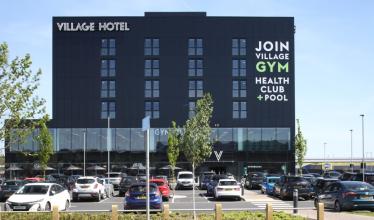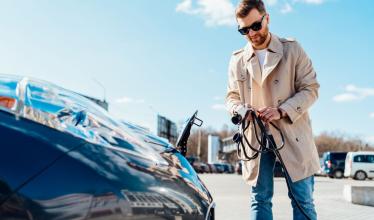Find the most recent network rankings here: Zapmap's best en-route charging networks in the UK 2023-2024
New Zap-Map survey identifies the most and least popular electric vehicle charging networks as rated by EV drivers
Zap-Map, the UK’s leading electric vehicle (EV) mapping service, has today released its annual public charging network satisfaction rankings.
The league table, now in its 4th year, comes from Zap-Map’s annual EV charging survey conducted in October 2021, which had over 3,000 respondents and is the most established and comprehensive survey of EV drivers in the UK. For the first time, Zap-Map awarded a new ‘Best EV Charging Network’ accreditation to the top scorer, and ‘EV Driver Recommended’ badge given to the top three.
As part of the survey, respondents rated their overall satisfaction for the networks they use regularly, which is then used to rank each network out of a maximum of five stars. They also rated their level of satisfaction with the networks in four key areas: reliability, ease of use, cost and facilities
In first place overall this year is InstaVolt – the rapid charging network scored particularly highly for reliability and ease of use, securing its ‘Best EV Charging Network’ badge. Taking the ‘EV Driver Recommended’ second and third places respectively are two other rapid charging networks, MFG EV Power and Osprey. The table below shows the full list of Zap-Map users’ most popular public EV charging networks in the UK.
Zap-Map user ratings for UK public EV charging networks

This year there are four new entrants to the league table. MFG EV Power is a new network that has installed charging hubs at its network of petrol stations, and has entered the list for the first time in a strong 2nd position.
GRIDSERVE Electric Highway is another new network, which has both rolled out its pioneering electric forecourt in Braintree and also bought – and is in the process of upgrading – Ecotricity’s network of chargers. GRIDSERVE Electric Highway came joint 5th overall and a noteworthy 1st place for facilities.
ubitricity, the on-street charging network, and EV.Charge Online, with its extensive network of destination chargers, while not new networks, made the league table for the first time in position 9th and 13th respectively.
It is also worth highlighting that ChargePlace Scotland – which came in 13th place overall – took 1st place for cost, thanks to many of its extensive network of rapid charge points being free to use. ChargePlace Scotland is also going through a transition period, with a focus on improving the consumer experience.
At the bottom of the table, the legacy Ecotricity Electric Highway points that have not yet been migrated to GRIDSERVE’s new chargers are in last place overall for the second year in a row. Furthermore, bp pulse has this year slipped into the bottom three, where it is also joined by bp pulse owned network Charge Your Car. It is worth noting that not all issues experienced by EV drivers can be attributed directly to the network, as they do not always own the chargers and set the tariffs.
Market context: High growth in both EV drivers and charge point infrastructure
2021 has seen a remarkable growth in the number of new EV drivers on the road and the charging infrastructure that supports them. Not only does the UK now have close to 30,000 charging devices, but we have also seen new networks entering the market, a high growth in ultra-rapid chargers, the installation of charging hubs across the country and the growth of options for on-street charging. Looking forward to next year, all these trends are expected to continue with a high level of infrastructure investment committed by many networks.
Melanie Shufflebotham, Co-founder & COO at Zap-Map, said:
“Despite significant changes over the course of the year, there are some things that remain the same. EV drivers are clear about the factors that make for a good charging experience, namely reliability and ease of use – and these should be key priorities for the UK’s public charging networks.
“The Zap-Map survey shows that while this is being delivered by some, others are falling short and there needs to be improvement. As we move from the early adopters towards mass EV adoption, making public charging simple becomes more important than ever.”
Details of highest and lowest ranked EV charge point networks

#1 – InstaVolt – Star Rating 4.5
In first place this year, and with an overall rating of 4.5 stars, InstaVolt maintains its place in the top two for the fourth year running.
With more than 650 rapid and ultra-rapid charging devices across the country, InstaVolt has the second largest rapid network after bp pulse (third if including the Tesla Supercharger network). The network, which provides reliable rapid chargers with simple contactless payment from Aberdeen to Plymouth, came in first place for both reliability and ease of use.
Feedback highlighted the reliability of the InstaVolt chargers as well as the simple pay-as-you-go access provided through contactless payment. Respondents to the survey described InstaVolt devices as “very reliable at locations I am happy to spend time at” and “the best.” Others highlighted the network as “my go-to charger,” although perhaps the pithiest description is this one: “Expensive but always works.”
InstaVolt did make some gains in terms of cost this year, however, climbing from 8th place last year to 6th place in Zap-Map’s most recent survey. It should be noted that the survey was completed prior to the network’s recent price rise to 45p per kWh – one of several networks to have hiked prices recently – citing increases in wholesale energy prices.
In contrast, the network made much larger gains for facilities. It climbed from 7th to 3rd place, thanks doubtless to partnerships with Costa Coffee, KFC, Starbucks and McDonalds coming to fruition over the course of 2021. Going forward InstaVolt has announced it will be installing 10,000 ultra rapid devices by 2030.
As ever, it is worth noting that older generation Renault Zoe drivers are unable to use InstaVolt devices, which have no AC connectors.
Network stats:
- ● 580 rapid charging devices and more than 70 ultra-rapid devices
- ● 2nd largest rapid network after bp pulse (and Tesla)
- ● Find InstaVolt devices at Costa Coffee, KFC, Starbucks and McDonalds outlets as well as retail parks, gyms and service stations

#2 – MFG EV Power – Star Rating 4.0
In second place this year is a new entrant to the league table, MFG EV Power. The ultra-rapid charging network belongs to Motor Fuel Group (MFG), the largest independent forecourt operator in the UK, and achieved an overall rating of 4.0 stars.
With more than 95 ultra-rapid charging devices at service stations across the UK, MFG EV Power is currently one of the smaller networks. However, the network is definitely one to watch. Over the next ten years, MFG is planning to invest some £400 million in 3,000 ultra-rapid 150kW and 350kW EV charging devices at forecourts up and down the country.
What’s more, MFG EV Power has clearly made a strong start. The network came in 2nd place for both reliability and ease of use, thanks to reliable chargers and simple payment options, which include contactless and the MFG EV Power app. All of the network’s charge points will also become Zap-Pay enabled by the start of 2022.
Feedback highlighted the network’s facilities and reliable charging hubs: MFG EV Power aims to have four to eight charging bays per site. Respondents to the survey described MFG EV Power devices as “good fast chargers and usually on a forecourt with facilities,” even going so far as to say that the “excellent facilities and the safe/secure environment at 24/7 petrol stations is a real winner.” Cost also came up, with one user saying, “expensive but great location.”
Indeed, despite being slightly cheaper than both InstaVolt and Osprey, at 39p/kWh, MFG EV Power came in behind them for cost – in 8th. However, the ultra-rapid network came in a strong second for facilities, largely due to the fact that its devices are located at service stations.
Network stats:
- ● Growing rapid network with 95+ ultra-rapid devices located at Motor Fuel Group forecourts across the UK
- ● Zap-Pay network partner, the simple way to pay for EV charging across networks

#3 – Osprey – Star Rating 4.0
This year, Zap-Pay partner Osprey maintains its overall position in third place, having previously leapfrogged from 8th place in 2019 to 3rd in 2020.
Achieving an overall rating of 4.0 stars, Osprey’s growing network of more than 240 mainly rapid and ultra-rapid devices allows charging for all EV models, as devices are also equipped with fast AC connectors. Its combination of reliable chargers, visible locations and simple payment via contactless or Zap-Pay means that Osprey came in 3rd place for reliability and 4th place for ease of use.
Feedback highlighted this, with comments from users such as “reliable, easy to use, contactless payment” and “good locations and tend to work well.” Other respondents emphasised Osprey’s compatibility with all EV models, describing them as “great chargers with AC and DC” and “a model for other networks”.
Some consider Osprey’s recently increased charging price of 40p/kWh to be “more expensive than desirable,” as one respondent put it, something the network’s position of joint 6th with InstaVolt for cost appears to reflect. The network came in 4th place for cost last year, when its tariff was 35p/kWh.
Many Osprey devices are located at pubs or restaurants, through the network’s relationship with Marston’s. This has served Osprey relatively well this year, earning the network a ranking of 5th for facilities, coming in behind GRIDSERVE Electric Highway, MFG EV Power and (in joint 3rd for facilities) InstaVolt and Pod Point. Osprey may well climb the rankings here over the course of 2022, however. The network is investing £75 million in 1500 rapids by 2025, including charging hubs across the UK, the first of which opened recently in Wolverhampton.
Network stats:
- ● More than 230 rapid charging devices, 4 ultra-rapid devices
- ● National network located at high-quality sites such as Marston’s pub/restaurant chain
- ● Zap-Pay launch partner offering simple cross network charging
At the other end of the table, the key issues for the low ranking of the bottom three networks in the survey are the lack of reliability and ease of use. Pricing and the lack of amenities also play their part, however. The lowest ranking networks are described in more detail below.

#16 – bp pulse – Star Rating 2.5
The bp pulse network was one of first networks in the UK (under the Chargemaster brand) and now boasts the largest network in terms of connectors with a mix of more than 2,980 ultra-rapid, rapid, fast and slow charging devices, and stretches from Inverness to Jersey.
The network, which last year came 13th overall, has now slipped into the bottom three. It also earned a low ranking for reliability and ease of use, coming in the bottom three and bottom four respectively.
Survey respondents commented that units are starting to become unreliable, also noting price rises and poor customer service. There were also mixed comments about the network’s app and support line. bp pulse has acknowledged issues with reliability and has been investing heavily in both customer care and its charge point management platform, as well as its charge point portfolio, so expect to see an improvement next year.
Network stats:
- ● Mixed network of 100 ultra-rapid charging devices, 650 rapid devices, 1,900+ fast devices and 300+ slow devices
- ● Third largest public charging network, after ubitricity and Pod Point in terms of devices
- ● Largest multi-brand* rapid charging network

#17 – Charge Your Car – Star Rating 2.5
Charge Your Car’s UK-wide network, which is owned by bp pulse, consists of a mix of more than 680 rapid, fast and slow charging devices. The network, which came 15th overall last year, earned a low ranking in all categories (including last place for facilities) with the exception of cost, where it came in 8th.
Feedback highlighted poor reliability, with chargers often being out of service, slow maintenance response and patchy customer service. Many respondents saw Charge Your Car as old and complained about the usability of the app.
Although overall in second from the bottom once more, EV drivers have ranked CYC in 8th place for price, reflecting the fact that CYC allows the host site to set the pricing. This of course results in a variety of prices across different areas, with many devices being free to use.
Network stats:
- ● Mixed network of 75 rapid charging devices, 530+ fast devices and 80 slow devices
- ● CYC allows the host site to set the pricing, resulting in a variety of prices across different areas

#18 – Legacy Ecotricity Electric Highway – Star Rating 2.0
The Electric Highway was bought by GRIDSERVE in June 2020, and GRIDSERVE is busy upgrading all the old sites to new GRIDSERVE devices. As such, this “network” no longer belongs to Ecotricity, but has been separated out as it is still the legacy Ecotricity Electric Highway experience.
This legacy network finds itself at the bottom of the ranking again this year for the 100 or so chargers across the motorway service network that have not yet been upgraded.
As well as having the lowest overall ranking, the legacy Ecotricity’s Electric Highway also came last for reliability and ease of use for the second year running.
Survey respondents commented that legacy Ecotricity Electric Highway devices were “highly variable and usually only one CCS connector, which causes queues,” and also “unreliable and not enough of them.” Others emphasised that they are “not fast enough,” with customer service issues also arising around the network’s app and helpline.
On a slightly more positive note, the legacy Ecotricity Electric Highway points came in 8th for facilities. With most chargers located at motorway service areas, almost all locations have plenty of amenities. The network also came in 10th place for cost.
Network stats:
- ● 96 rapid charging devices and 13 fast devices mainly located at motorway service areas
* ‘Multi-brand’ networks are capable of use by multiple models of electric vehicle, such as Nissan, VW, Kia in contrast to the Tesla Supercharger network, which can currently only be accessed by Tesla drivers.



